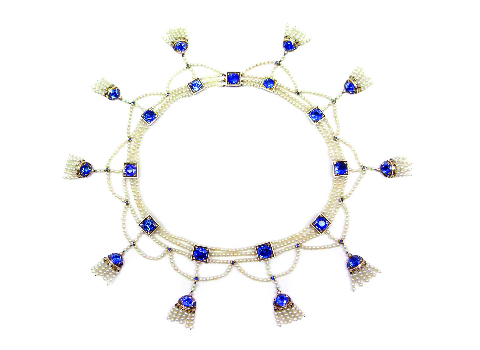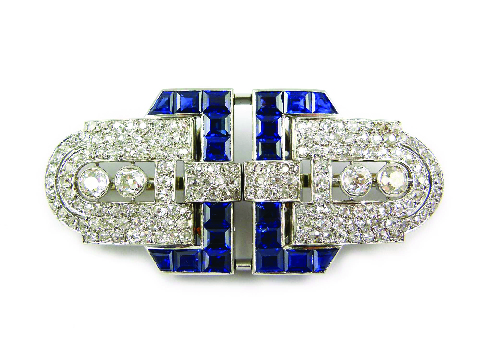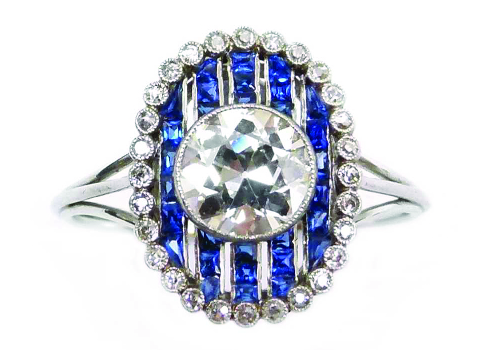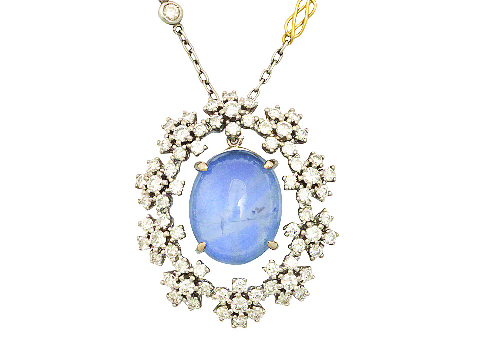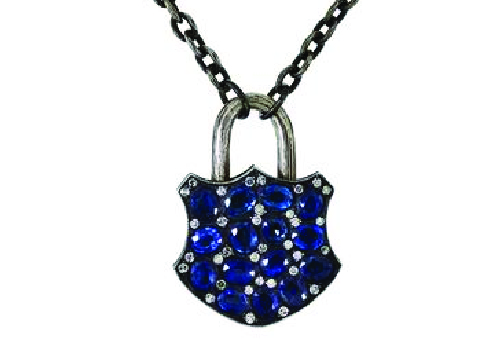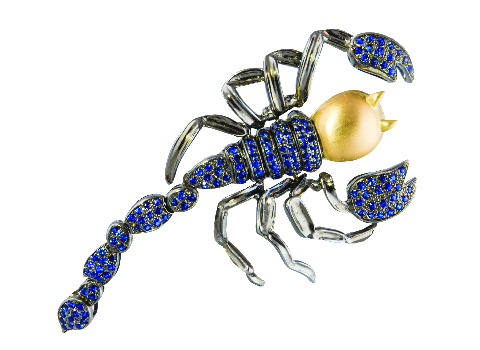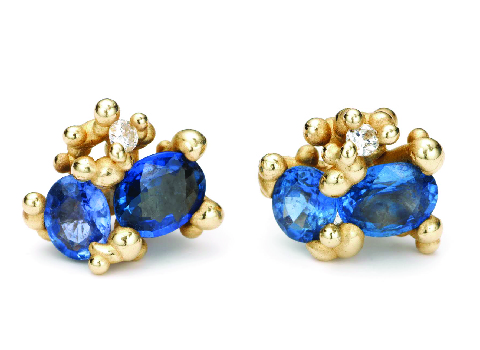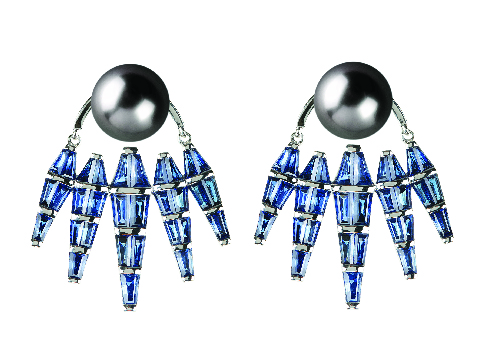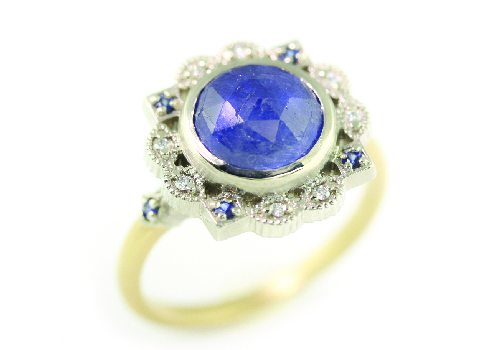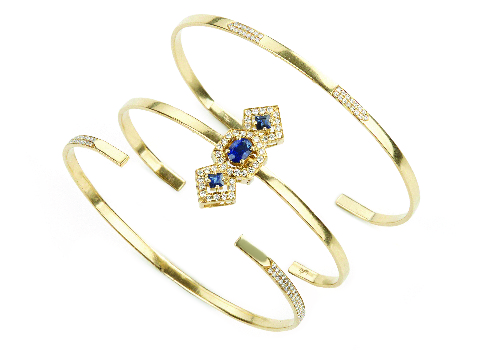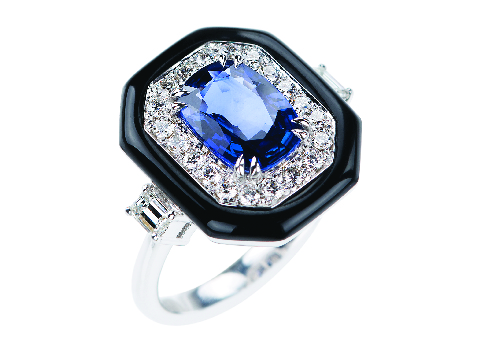September’s Birthstone is 2000 YEARS OLD AND SHINING AS BRIGHT AS EVER
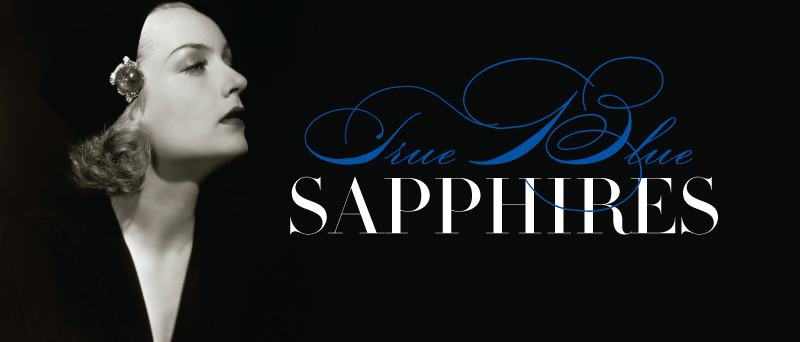
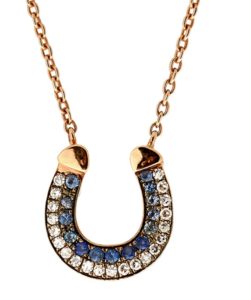
Selim Mouzannar’s sapphire and diamond horseshoe pendant
We are bringing back this story from last year on Sapphires. The article traces some of the history on the legendary gem and many of the celebrities who counted sapphires as their favorites. It is also this month’s birthstone and there are numerous antique, vintage and modern styles from which to choose for lucky September babies. Having a case of the blues has never felt so good!
Modern designers have been working with fancy colored sapphires in all cuts and colors for some time, but the return of the regal blue gem is turning up in a variety of styles and independent designer collections—from geometric cuffs to scorpion brooches. Then there is Erica Courtney, who loves to unearth unusual gemstones and has introduced a sapphire that changes from various shades of blue to purple to violet in 2016. Still, other talented jewelers continue to introduce more and more of the big three (sapphires, rubies and emeralds into their engagement and wedding rings—switching our way of thinking about bridal: what was once traditional is now alternative and alternative is now the new normal.
Here’s a bit of history behind these historical stones: Medieval kings wore the gem around their necks as a defense from harm and by the 11th century, sapphires were chosen for ecclesiastical rings. In Roman times it was believed if someone were untruthful, the sapphire’s color would change.
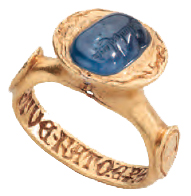
From the Benjamin Zucker collection, a medieval sapphire and gold ring set with a 10th-century sapphire. Sold during Les Enluminures Cycle of Life exhibit
While researching my book, If These Jewels Could Talk: The Legends Behind Celebrity Gems, I found that when the first betrothal rings were given by royal families in the 14th and 15th centuries, sapphires were favored over other gems, many passed down through generations of nobility. This all made perfect sense: Sapphires symbolize romantic love, truth, fidelity and loyalty.
If we fast-forward to 1981, Lady Diana Spencer is credited with bringing back the sapphire engagement ring when Prince Charles proposed. Jewelers around the world wasted no time in turning out similar style rings almost immediately after Diana chose the vivid blue from a selection shown by Garrard of Mayfair, crown jeweler at the time. A global trend was born for women who wanted an engagement ring fit for a modern-day princess.
But it was in the 1930s and ’40s that sapphires had first regained popularity for engagement rings, worn by some of Hollywood’s most glamorous leading ladies. It was also during this period that Cabochon-cut and star sapphires surged in popularity as movie-goers admired the stone’s beauty on film, as worn by icons of the day.
Mary Pickford, known to audiences as “America’s Sweetheart” for her acting roles, was also an enterprising businesswoman. She co-founded the film studio United Artists Corporation, along with Charlie Chaplin, D.W. Griffith and Douglas Fairbanks Sr., whom she married in 1920.
Pickford had an eye and a desire for important jewels. Fairbanks acquired the most exceptional of all star sapphires for her, The Star of Bombay, which the well-known jeweler of the time, Trabert & Hoeffer (which later became Trabert & Hoeffer-Mauboussin) had set into a platinum ring. The stone features a six-point star. The three crossed lines of the star sapphire represent faith, hope and destiny, sometimes associated with three angels who offer protection to those who wear the stone. She also owned quite a few other sapphire and diamond bracelets from Trabert & Hoeffer, which had become her favorite jeweler. Upon her death, Pickford bequeathed the Star of Bombay, which she had owned for almost 60 years, to the Smithsonian, where it resides today.
The ‘sapphire craze’ spread across Hollywood. Joan Crawford was renowned for her love of the gemstone—so much so that the press dubbed her suite of sapphires “Joan Blue.” Through a succession of four marriages and three divorces, Crawford received gifts of fine jewels, and also purchased pieces for herself. The bigger, the better—and the showier—was the way in which she liked to wear her jewelry. She often attached clips to necklaces or wore them on head wraps with big gemstone necklaces.
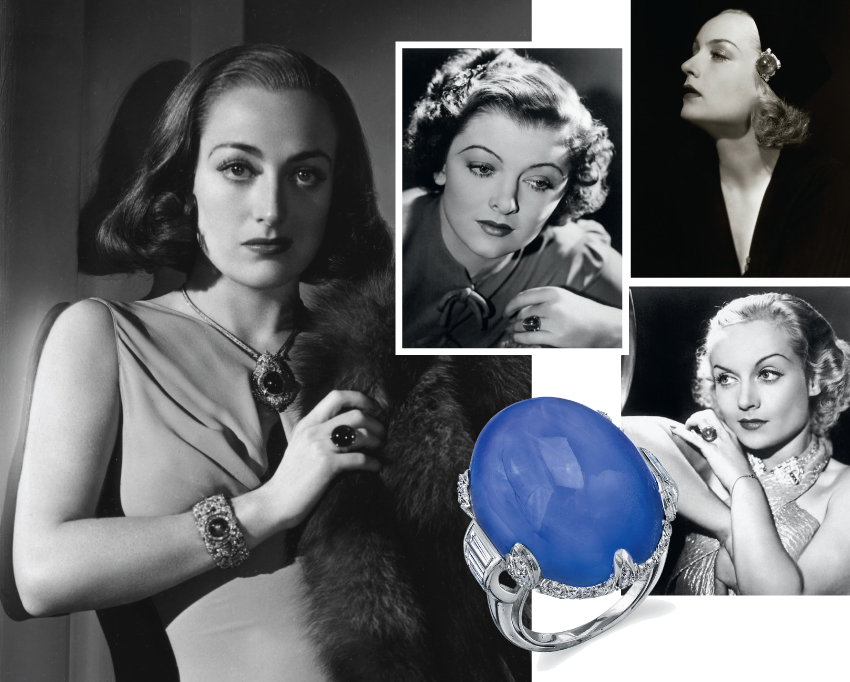
Clockwise from left: portrait of Joan Crawford in 1937 Mgm/George Hurrell/The Kobal Collection At Art Resource NY and…(Myrna Loy wearing her star sapphire courtesy of CorbisCarole Lombard wearing her mega white star sapphires, courtesy of Corbis andSunset Boulevard/Corbis, Myrna Loy’s sapphire ring courtesy of Neil Lane as featured in If These Jewels Could Talk)
After Crawford’s first marriage to Douglas Fairbanks Jr.—whose father had lavished Mary Pickford with some of the finest sapphires in the world—ended in divorce, she became engaged to actor and frequent co-star Franchot Tone. Her favorite jeweler, Raymond Yard created an engagement ring featuring a 70-carat star sapphire. She already owned a 72-carat emerald-cut sapphire ring, and would often wear them together. The most publicized of all of Crawford’s pieces were designed by Yard–a bracelet with three-star sapphires of 73.15 carats, 63.61 carats and 57.65 carats in a wide platinum Art Deco bracelet, featuring fine piercing work with baguette, half-moon and marquise-shaped diamonds.
All of actor William Powell’s leading ladies, both on and off screen, wore star sapphires, and they were all true blue in their choice of jewelry. Powell bought his second wife, actress Carole Lombard, a star sapphire ring when they married in 1931.Though they stayed together for just 26 months, the pair remained friends and continued to star in movies together, including My Man Godfrey in 1936. Lombard opted to wear her own jewelry in the film, including a huge sapphire ring that Powell had bought for her and a 150-carat sapphire, which she purchased and had mounted as a brooch; it could be converted to also be worn either as a ring or a pendant. In the film, she wears the brooch at the neckline of a full-length evening gown with a duster.
Another woman in Powell’s life was co-star Myrna Loy, who acted with him in 14 films, including the Thin Man series. The duo were best known for their witty repartee and comeback lines as Nick and Nora Charles. Loy also owned an important star sapphire, set into a platinum leaf mounting with baguette diamonds on the shank. According to the ring’s most recent owner, Hollywood jeweler to the stars and collector, Neil Lane, Myrna Loy wore the sapphire in the Thin Man publicity shots. Lane notes that this particular Art Deco ring is truly reflective of the Golden Age of Hollywood. It is thought the ring was created by Paul Flato.
William Powell was also attached to Jean Harlow, an avid collector of sapphires and an actress who knew her own mind was Jean Harlow. While it’s now common to clip brooches to the skinny strap of a gown, pin them in the hair, scatter them at the waist of a dress or a neckline, Harlow provocatively wore her jewelry like this long before its time. She also wore them quite sensually, attached to the V of a backless dress. There was a story doing the rounds in Hollywood that when leading man William Powell first proposed to Harlow in 1936, he offered her a beautiful, but traditional, diamond ring; Harlow accepted the proposal but refused the ring.The platinum-blonde bombshell supposedly felt a large star sapphire would better suit her personal style. Powell purchased a large sapphire. She wore it on the set of Libeled Lady and her final film, Saratoga in 1937 when she was taken seriously ill and died with Powell at her side.
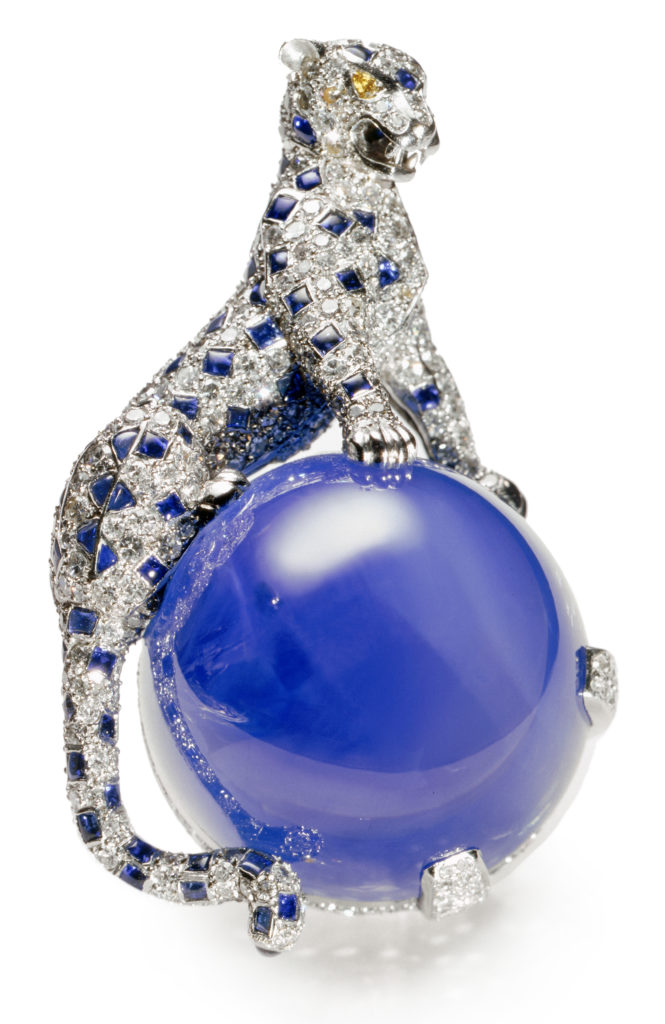
The Duchess of Windsor’s three-dimensional platinum panther atop a 152.35-carat Kashmir sapphire cabochon. STUDIO GÉRARD, CARTIER COLLECTION © CARTIER
The Duchess of Windsor played a part in the renewed popularity of sapphires in the 1950s when she was seen wearing a Cartier three-dimensional panther clip brooch, featuring a 152.35-carat Kashmir cabochon sapphire, designed in 1949. TheDuchess was partial to sapphires in a variety of pieces: she, like many wearers, believed the gem brought out the color of her eyes. This classic Cartier sapphire is set in white gold and platinum with single-cut white diamonds. It has yellow pear-shaped diamond eyes with smaller sapphire cabochons for the feline’s spots. It was designed under the tutelage of Cartier’s creative director Jeanne Toussaint, whom he nicknamed ‘the Panther’. Toussaint created many different versions of the powerful cat. Her prowess and instincts about jewelry and what women wanted were instrumental in the panther becoming synonymous with projecting an aura of confidence and fearlessness.
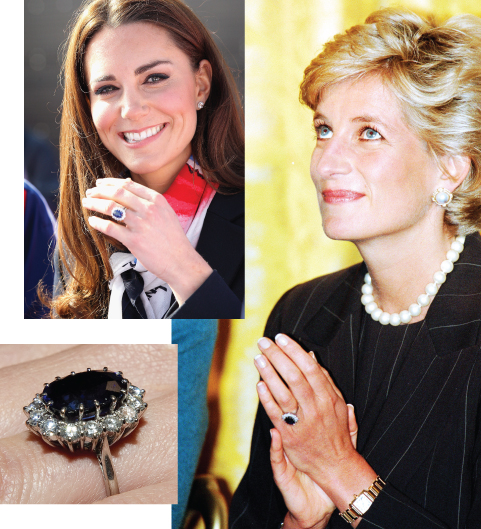
All images in this collage courtesy of Rex/Shuttershock
Keeping jewels in the family is not just part of the royal tradition.Women everywhere inherit keepsakes and heirlooms from their loved ones. But those that are passed down from princess to princess markan occasion in history. Unfortunately Princess Diana was not alive to see her eldest son Prince William marry, or the moment when William presented Kate Middleton with his mother’s engagement ring: a 12-carat oval blue Ceylon sapphire, surrounded by solitaire diamonds, set in 18K white gold.
Lady Diana Spencer was 19 years old when she became engaged to The Prince of Wales. Diana brought the fiery blue stone, set in an antique style with a halo of diamonds, back as the engagement ring to own, and she continued to wear it even after her divorce from Prince Charles.In 1997, after Diana’s tragic death, her sons were allowed to select mementos from her jewelry collection. Twelve-year-old Harry picked out the sapphire ring, and William chose his mother’s yellow gold Cartier watch. When William announced his intention to wed Kate Middleton, the brothers swapped mementos. Asked in a television interview about his marriage proposal, William told the journalist that he had been carrying the ring around for weeks and “literally would not let it go”: “It’s my mother’s engagement ring so I thought it was quite nice… she’s not going to be around to share in any of the fun and excitement of it all—this was my way of keeping her close to it all… it’s a sapphire with some diamonds…I am sure everyone recognizes it from previous times.”
As Kate Middleton lifted her hand to show the ring to the cameras, a media blitz was created around the world; jewelry store phones began to ring off the hook and designers started designing the next wave of sapphire rings.
- S.J.Phillips early 20th century pearl and sapphire necklace
- S.J. Phillips Art Deco Clip Brooch
- S. J. Phillips sapphire and diamond ring, circa 1910
- Glorious Antique Jewelry star sapphire and diamond pendant
Whatever September girls choose—an antique engagement ring, bracelet or pendant dating back to the days of Joan Crawford or before, an exclusively cut bridal ring from an emerging talent, a protective talisman or a more trendsetting style, this is their year to shine.
- Sevan Bakaci sapphire padlock
- Gaelle Khouri sapphire scorpion brooch
- Ruth Tomlinson sapphire earrings
- Nikos Koulis earrings
- Megan Thorne Rose cut sapphire and diamond ring
- R.Y.M Jewelry sapphire and 18K gold cuff
- Lynn Ban Sapphire ring
- Nikos Koulis sapphire, onyx and diamond ring

